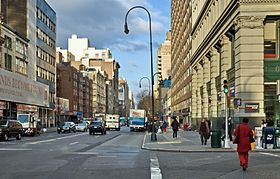Manhattanʼs 'Little Spain' comes to big screen, documenting Hispanic immigration in New York City
Friday, November 28, 2014

The Spanish Benevolent Society announced on Tuesday a DVD edition of the film Little Spain, directed by Artur Balder, is now available on their official website. The film, which summarizes a part of Hispanic immigration in the United States displaying the history of New York City (NYC), is based upon a set of old photographs and testimonies showing a neighborhood called Little Spain in Manhattan, situated at the West End of 14th Street, in the time when it was densely populated by Spaniards and Hispanic immigrants.

Image: Leif Knutsen.
According to the film's content and press release, Little Spain was populated by Spaniards, Puerto Ricans, and other Hispanic immigrants, located in south Chelsea and West Village, around the west end of 14th Street. The Spaniards tended to live in close proximity to one another; and, in many cases, in close proximity to Spanish-speakers from countries other than Spain — such as Puerto Ricans in New York.
In the film, the Spanish-American director and journalist Artur Balder traces the journey of those who left Spain and South America in search of a better life in the United States, describing the story of its most important entrance port, New York City, and the formation of the Little Spain community.
The 60 minute, feature-length, documentary looks back at the founding of La Nacional in 1868 and the uptick in migration from Spain following its loss of Cuba in 1898; continuing through to the Hispanic apex in the area, after the Spanish Civil War of 1936–1939, finally charting the community’s sharp decline in the 1970s and 1980s.
Well into the 1960s Spanish was still commonly spoken on 14th Street. The film also displays footage of the Santiago Apóstol festival, or St. James Day festival, which died out in the early 1990s as the remnants of the Hispanic community left that part of the city.
Artur Balder worked closely with New York's Museum of Modern Art (MoMA), and with the Film Society of the Lincoln Center in order to show the film in NYC. He is currently preparing two new projects: The Reality of the Imaginary, with Nobel prize-winner Mario Vargas Llosa, Cervantes literature award recipient José Manuel Caballero Bonald, and artist Joan Castejón, expected to premier at the MoMA in 2015. The second project being with Armenian–American painter Tigran Tsitoghdzyan and renowned art critic Donald Kuspit.
The film shows how Spain contributed to the vast wave of emigration of Europeans to the Americas which, in the late nineteenth and early twentieth century, transformed the three continents. The Spaniards were a very small proportion of US immigration compared to some of the other national or ethnic groups of immigrants that came to the United States, such as Italian, Irish, and Polish.
Related news
- "Galician emigrant Rufino López receives 2013 Spanish-American International Award" — Wikinews, November 2, 2013
Sources
- Annie Martin. "Artur Balder details Hispanic immigration documentary 'Little Spain'" — United Press International, November 25, 2014
- Spanish Benevolent Society. "LITTLE SPAIN. Press Release November 25, 2014" — Spanish Benevolent Society, November 25, 2014
- Manuel Varela. "Un 'Coruña' en el viejo Nueva York" — La Opinión de A Coruña, November 18, 2014 (Spanish)
- Xesús Fraga. "«Little Spain»" — La Voz de Galicia, November 18, 2014 (Spanish)



